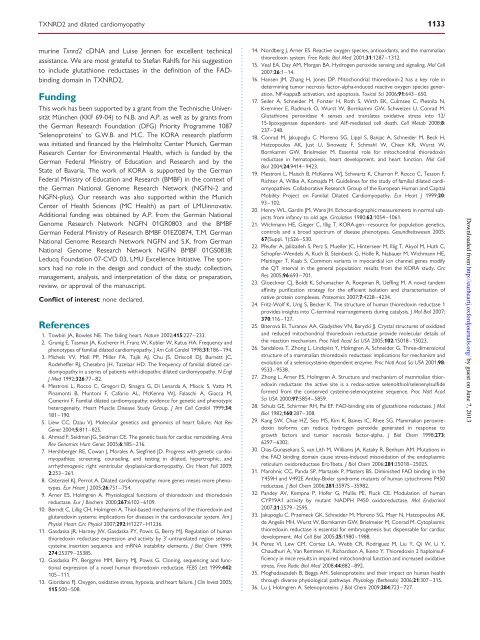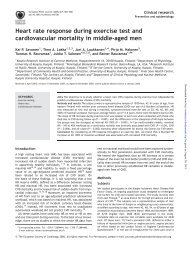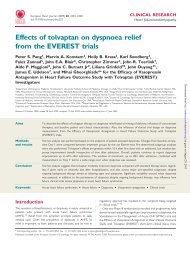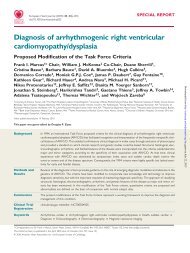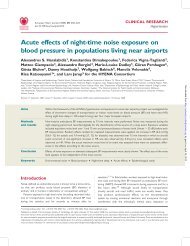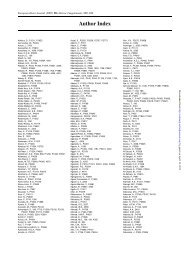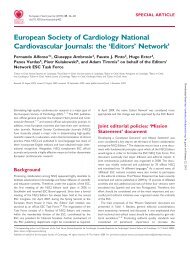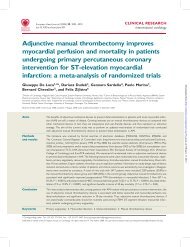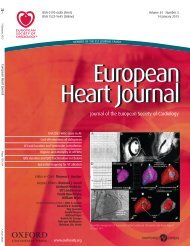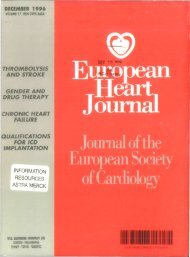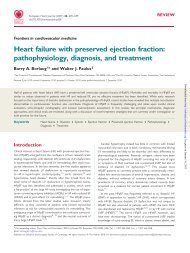Mutations in the mitochondrial thioredoxin reductase gene TXNRD2 ...
Mutations in the mitochondrial thioredoxin reductase gene TXNRD2 ...
Mutations in the mitochondrial thioredoxin reductase gene TXNRD2 ...
You also want an ePaper? Increase the reach of your titles
YUMPU automatically turns print PDFs into web optimized ePapers that Google loves.
<strong>TXNRD2</strong> and dilated cardiomyopathy 1133<br />
mur<strong>in</strong>e Txnrd2 cDNA and Luise Jennen for excellent technical<br />
assistance. We are most grateful to Stefan Rahlfs for his suggestion<br />
to <strong>in</strong>clude glutathione <strong>reductase</strong>s <strong>in</strong> <strong>the</strong> def<strong>in</strong>ition of <strong>the</strong> FADb<strong>in</strong>d<strong>in</strong>g<br />
doma<strong>in</strong> <strong>in</strong> <strong>TXNRD2</strong>.<br />
Fund<strong>in</strong>g<br />
This work has been supported by a grant from <strong>the</strong> Technische Universität<br />
München (KKF 69-04) to N.B. and A.P. as well as by grants from<br />
<strong>the</strong> German Research Foundation (DFG) Priority Programme 1087<br />
‘Selenoprote<strong>in</strong>s’ to G.W.B. and M.C. The KORA research platform<br />
was <strong>in</strong>itiated and f<strong>in</strong>anced by <strong>the</strong> Helmholtz Center Munich, German<br />
Research Center for Environmental Health, which is funded by <strong>the</strong><br />
German Federal M<strong>in</strong>istry of Education and Research and by <strong>the</strong><br />
State of Bavaria. The work of KORA is supported by <strong>the</strong> German<br />
Federal M<strong>in</strong>istry of Education and Research (BMBF) <strong>in</strong> <strong>the</strong> context of<br />
<strong>the</strong> German National Genome Research Network (NGFN-2 and<br />
NGFN-plus). Our research was also supported with<strong>in</strong> <strong>the</strong> Munich<br />
Center of Health Sciences (MC Health) as part of LMU<strong>in</strong>novativ.<br />
Additional fund<strong>in</strong>g was obta<strong>in</strong>ed by A.P. from <strong>the</strong> German National<br />
Genome Research Network NGFN 01GR0803 and <strong>the</strong> BMBF<br />
German Federal M<strong>in</strong>istry of Research BMBF 01EZ0874, T.M. German<br />
National Genome Research Network NGFN and S.K. from German<br />
National Genome Research Network NGFN BMBF 01GS0838;<br />
Leducq Foundation 07-CVD 03, LMU Excellence Initiative. The sponsors<br />
had no role <strong>in</strong> <strong>the</strong> design and conduct of <strong>the</strong> study; collection,<br />
management, analysis, and <strong>in</strong>terpretation of <strong>the</strong> data; or preparation,<br />
review, or approval of <strong>the</strong> manuscript.<br />
Conflict of <strong>in</strong>terest: none declared.<br />
References<br />
1. Towb<strong>in</strong> JA, Bowles NE. The fail<strong>in</strong>g heart. Nature 2002;415:227–233.<br />
2. Grunig E, Tasman JA, Kucherer H, Franz W, Kubler W, Katus HA. Frequency and<br />
phenotypes of familial dilated cardiomyopathy. J Am Coll Cardiol 1998;31:186–194.<br />
3. Michels VV, Moll PP, Miller FA, Tajik AJ, Chu JS, Driscoll DJ, Burnett JC,<br />
Rodeheffer RJ, Chesebro JH, Tazelaar HD. The frequency of familial dilated cardiomyopathy<br />
<strong>in</strong> a series of patients with idiopathic dilated cardiomyopathy. N Engl<br />
J Med 1992;326:77–82.<br />
4. Mestroni L, Rocco C, Gregori D, S<strong>in</strong>agra G, Di Lenarda A, Miocic S, Vatta M,<br />
P<strong>in</strong>amonti B, Muntoni F, Caforio AL, McKenna WJ, Falaschi A, Giacca M,<br />
Camer<strong>in</strong>i F. Familial dilated cardiomyopathy: evidence for <strong>gene</strong>tic and phenotypic<br />
hetero<strong>gene</strong>ity. Heart Muscle Disease Study Group. J Am Coll Cardiol 1999;34:<br />
181–190.<br />
5. Liew CC, Dzau VJ. Molecular <strong>gene</strong>tics and genomics of heart failure. Nat Rev<br />
Genet 2004;5:811–825.<br />
6. Ahmad F, Seidman JG, Seidman CE. The <strong>gene</strong>tic basis for cardiac remodel<strong>in</strong>g. Annu<br />
Rev Genomics Hum Genet 2005;6:185–216.<br />
7. Hershberger RE, Cowan J, Morales A, Siegfried JD. Progress with <strong>gene</strong>tic cardiomyopathies:<br />
screen<strong>in</strong>g, counsel<strong>in</strong>g, and test<strong>in</strong>g <strong>in</strong> dilated, hypertrophic, and<br />
arrhythmogenic right ventricular dysplasia/cardiomyopathy. Circ Heart Fail 2009;<br />
2:253–261.<br />
8. Osterziel KJ, Perrot A. Dilated cardiomyopathy: more <strong>gene</strong>s means more phenotypes.<br />
Eur Heart J 2005;26:751–754.<br />
9. Arner ES, Holmgren A. Physiological functions of thioredox<strong>in</strong> and thioredox<strong>in</strong><br />
<strong>reductase</strong>. Eur J Biochem 2000;267:6102–6109.<br />
10. Berndt C, Lillig CH, Holmgren A. Thiol-based mechanisms of <strong>the</strong> thioredox<strong>in</strong> and<br />
glutaredox<strong>in</strong> systems: implications for diseases <strong>in</strong> <strong>the</strong> cardiovascular system. Am J<br />
Physiol Heart Circ Physiol 2007;292:H1227–H1236.<br />
11. Gasdaska JR, Harney JW, Gasdaska PY, Powis G, Berry MJ. Regulation of human<br />
thioredox<strong>in</strong> <strong>reductase</strong> expression and activity by 3 ′ -untranslated region selenocyste<strong>in</strong>e<br />
<strong>in</strong>sertion sequence and mRNA <strong>in</strong>stability elements. J Biol Chem 1999;<br />
274:25379–25385.<br />
12. Gasdaska PY, Berggren MM, Berry MJ, Powis G. Clon<strong>in</strong>g, sequenc<strong>in</strong>g and functional<br />
expression of a novel human thioredox<strong>in</strong> <strong>reductase</strong>. FEBS Lett 1999;442:<br />
105–111.<br />
13. Giordano FJ. Oxygen, oxidative stress, hypoxia, and heart failure. J Cl<strong>in</strong> Invest 2005;<br />
115:500–508.<br />
14. Nordberg J, Arner ES. Reactive oxygen species, antioxidants, and <strong>the</strong> mammalian<br />
thioredox<strong>in</strong> system. Free Radic Biol Med 2001;31:1287–1312.<br />
15. Veal EA, Day AM, Morgan BA. Hydrogen peroxide sens<strong>in</strong>g and signal<strong>in</strong>g. Mol Cell<br />
2007;26:1–14.<br />
16. Hansen JM, Zhang H, Jones DP. Mitochondrial thioredox<strong>in</strong>-2 has a key role <strong>in</strong><br />
determ<strong>in</strong><strong>in</strong>g tumor necrosis factor-alpha-<strong>in</strong>duced reactive oxygen species <strong>gene</strong>ration,<br />
NF-kappaB activation, and apoptosis. Toxicol Sci 2006;91:643–650.<br />
17. Seiler A, Schneider M, Forster H, Roth S, Wirth EK, Culmsee C, Plesnila N,<br />
Kremmer E, Radmark O, Wurst W, Bornkamm GW, Schweizer U, Conrad M.<br />
Glutathione peroxidase 4 senses and translates oxidative stress <strong>in</strong>to 12/<br />
15-lipoxygenase dependent- and AIF-mediated cell death. Cell Metab 2008;8:<br />
237–248.<br />
18. Conrad M, Jakupoglu C, Moreno SG, Lippl S, Banjac A, Schneider M, Beck H,<br />
Hatzopoulos AK, Just U, S<strong>in</strong>owatz F, Schmahl W, Chien KR, Wurst W,<br />
Bornkamm GW, Brielmeier M. Essential role for <strong>mitochondrial</strong> thioredox<strong>in</strong><br />
<strong>reductase</strong> <strong>in</strong> hematopoiesis, heart development, and heart function. Mol Cell<br />
Biol 2004;24:9414–9423.<br />
19. Mestroni L, Maisch B, McKenna WJ, Schwartz K, Charron P, Rocco C, Tesson F,<br />
Richter A, Wilke A, Komajda M. Guidel<strong>in</strong>es for <strong>the</strong> study of familial dilated cardiomyopathies.<br />
Collaborative Research Group of <strong>the</strong> European Human and Capital<br />
Mobility Project on Familial Dilated Cardiomyopathy. Eur Heart J 1999;20:<br />
93–102.<br />
20. Henry WL, Gard<strong>in</strong> JM, Ware JH. Echocardiographic measurements <strong>in</strong> normal subjects<br />
from <strong>in</strong>fancy to old age. Circulation 1980;62:1054–1061.<br />
21. Wichmann HE, Gieger C, Illig T. KORA-gen–resource for population <strong>gene</strong>tics,<br />
controls and a broad spectrum of disease phenotypes. Gesundheitswesen 2005;<br />
67(Suppl. 1):S26–S30.<br />
22. Pfeufer A, Jalilzadeh S, Perz S, Mueller JC, H<strong>in</strong>terseer M, Illig T, Akyol M, Huth C,<br />
Schopfer-Wendels A, Kuch B, Ste<strong>in</strong>beck G, Holle R, Nabauer M, Wichmann HE,<br />
Meit<strong>in</strong>ger T, Kaab S. Common variants <strong>in</strong> myocardial ion channel <strong>gene</strong>s modify<br />
<strong>the</strong> QT <strong>in</strong>terval <strong>in</strong> <strong>the</strong> <strong>gene</strong>ral population: results from <strong>the</strong> KORA study. Circ<br />
Res 2005;96:693–701.<br />
23. Gloeckner CJ, Boldt K, Schumacher A, Roepman R, Ueff<strong>in</strong>g M. A novel tandem<br />
aff<strong>in</strong>ity purification strategy for <strong>the</strong> efficient isolation and characterisation of<br />
native prote<strong>in</strong> complexes. Proteomics 2007;7:4228–4234.<br />
24. Fritz-Wolf K, Urig S, Becker K. The structure of human thioredox<strong>in</strong> <strong>reductase</strong> 1<br />
provides <strong>in</strong>sights <strong>in</strong>to C-term<strong>in</strong>al rearrangements dur<strong>in</strong>g catalysis. J Mol Biol 2007;<br />
370:116–127.<br />
25. Biterova EI, Turanov AA, Gladyshev VN, Barycki JJ. Crystal structures of oxidized<br />
and reduced <strong>mitochondrial</strong> thioredox<strong>in</strong> <strong>reductase</strong> provide molecular details of<br />
<strong>the</strong> reaction mechanism. Proc Natl Acad Sci USA 2005;102:15018–15023.<br />
26. Sandalova T, Zhong L, L<strong>in</strong>dqvist Y, Holmgren A, Schneider G. Three-dimensional<br />
structure of a mammalian thioredox<strong>in</strong> <strong>reductase</strong>: implications for mechanism and<br />
evolution of a selenocyste<strong>in</strong>e-dependent enzyme. Proc Natl Acad Sci USA 2001;98:<br />
9533–9538.<br />
27. Zhong L, Arner ES, Holmgren A. Structure and mechanism of mammalian thioredox<strong>in</strong><br />
<strong>reductase</strong>: <strong>the</strong> active site is a redox-active selenolthiol/selenenylsulfide<br />
formed from <strong>the</strong> conserved cyste<strong>in</strong>e-selenocyste<strong>in</strong>e sequence. Proc Natl Acad<br />
Sci USA 2000;97:5854–5859.<br />
28. Schulz GE, Schirmer RH, Pai EF. FAD-b<strong>in</strong>d<strong>in</strong>g site of glutathione <strong>reductase</strong>. J Mol<br />
Biol 1982;160:287–308.<br />
29. Kang SW, Chae HZ, Seo MS, Kim K, Ba<strong>in</strong>es IC, Rhee SG. Mammalian peroxiredox<strong>in</strong><br />
isoforms can reduce hydrogen peroxide <strong>gene</strong>rated <strong>in</strong> response to<br />
growth factors and tumor necrosis factor-alpha. J Biol Chem 1998;273:<br />
6297–6302.<br />
30. Dias-Gunasekara S, van Lith M, Williams JA, Kataky R, Benham AM. <strong>Mutations</strong> <strong>in</strong><br />
<strong>the</strong> FAD b<strong>in</strong>d<strong>in</strong>g doma<strong>in</strong> cause stress-<strong>in</strong>duced misoxidation of <strong>the</strong> endoplasmic<br />
reticulum oxido<strong>reductase</strong> Ero1beta. J Biol Chem 2006;281:25018–25025.<br />
31. Marohnic CC, Panda SP, Martasek P, Masters BS. Dim<strong>in</strong>ished FAD b<strong>in</strong>d<strong>in</strong>g <strong>in</strong> <strong>the</strong><br />
Y459H and V492E Antley-Bixler syndrome mutants of human cytochrome P450<br />
<strong>reductase</strong>. J Biol Chem 2006;281:35975–35982.<br />
32. Pandey AV, Kempna P, Hofer G, Mullis PE, Fluck CE. Modulation of human<br />
CYP19A1 activity by mutant NADPH P450 oxido<strong>reductase</strong>. Mol Endocr<strong>in</strong>ol<br />
2007;21:2579–2595.<br />
33. Jakupoglu C, Przemeck GK, Schneider M, Moreno SG, Mayr N, Hatzopoulos AK,<br />
de Angelis MH, Wurst W, Bornkamm GW, Brielmeier M, Conrad M. Cytoplasmic<br />
thioredox<strong>in</strong> <strong>reductase</strong> is essential for embryo<strong>gene</strong>sis but dispensable for cardiac<br />
development. Mol Cell Biol 2005;25:1980–1988.<br />
34. Perez VI, Lew CM, Cortez LA, Webb CR, Rodriguez M, Liu Y, Qi W, Li Y,<br />
Chaudhuri A, Van Remmen H, Richardson A, Ikeno Y. Thioredox<strong>in</strong> 2 haplo<strong>in</strong>sufficiency<br />
<strong>in</strong> mice results <strong>in</strong> impaired <strong>mitochondrial</strong> function and <strong>in</strong>creased oxidative<br />
stress. Free Radic Biol Med 2008;44:882–892.<br />
35. Moghadaszadeh B, Beggs AH. Selenoprote<strong>in</strong>s and <strong>the</strong>ir impact on human health<br />
through diverse physiological pathways. Physiology (Be<strong>the</strong>sda) 2006;21:307–315.<br />
36. Lu J, Holmgren A. Selenoprote<strong>in</strong>s. J Biol Chem 2009;284:723–727.<br />
Downloaded from<br />
http://eurheartj.oxfordjournals.org/ by guest on June 7, 2013


